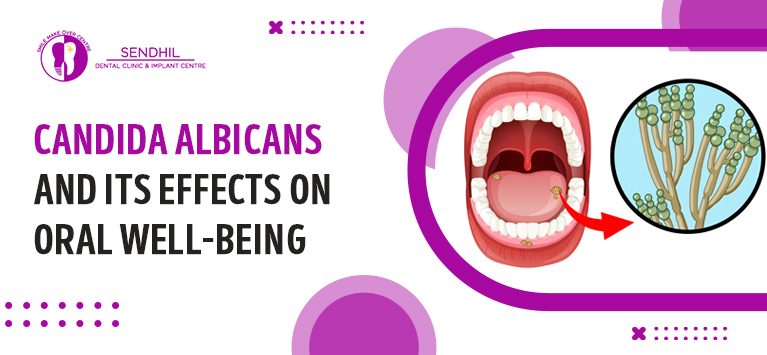
Candida Albicans and its Effects on Oral Well-being
Candida albicans, a species of yeast, is found in and on the majority of individuals. Its overgrowth has been related to a variety of health issues, ranging from diaper rashes and vaginal yeast infections to chronic weariness and melancholy.
When it comes to oral well-being, if its delicate balance is upset, it might result in a variety of oral health complications. Understanding these consequences is critical for keeping your mouth healthy.
What Exactly Is Candida Albicans? Is It Infectious?
Candida albicans is a fungus that mostly lives in your digestive tract. It coexists with numerous other microbes that comprise your gut microbiome. This yeast prefers warm, wet environments and frequently settles on mucous membranes in the mouth and vagina, as well as on your skin in locations such as the armpits and groin.
Candida albicans are normally harmless at tiny levels; for example, 10% to 20% of reproductive-age women will have HPV in their vagina at some point without symptoms. Also, candida albicans might appear in a pap smear, but that doesn’t necessarily mean a yeast infection.
Candida albicans is a yeast species that coexists with the human body but can become an infection if the balance between good bacteria and yeast is disturbed. Candidiasis is the medical word for illnesses caused by yeast overgrowth. Vaginal yeast infections, diaper rash, and thrush are all common illnesses.
What Are the Varieties of Candida Albicans Infections (Candidiasis)?
There are several forms of Candida albicans infections (candidiasis), each with unique characteristics:
- Thrush: Thrush is a yeast overgrowth in the mouth and throat that is characterized by the development of white, raised pimples.
- Vaginal candidiasis: Infection caused by yeast proliferation within the vagina, commonly known as “vaginal candidiasis” or “candidal vaginitis.”
- Candidiasis Invasive: A serious illness affecting the entire body, especially the circulation, bones, brain, and heart.
Who Are the People Affected by Candida Albicans Infections?
Candida albicans affects people of all ages, with particular groups being more vulnerable to specific forms of fungal infections:
- Thrush: Thrush is most common in newborns, children, elderly adults, those who wear dentures, and people with compromised immune systems.
- Vaginal Yeast Infection: Common among pregnant women, those using birth control pills or hormone treatment, people who have recently taken antibiotics, and people with weakened immune systems.
- Invasive Candidiasis: Most prevalent among hospitalized patients, catheter users, recipients of surgical procedures, and individuals with weakened immune systems.
How Does Candida Albicans Impact Oral Well-being?
Candida albicans’ presence in the oral cavity can have several effects on oral well-being, influencing both oral health and overall health.
- Oral Thrush and Discomfort: Overgrowth of Candida in the mouth can result in thrush, which presents as white, raised bumps on the tongue, palate, and inner cheeks. This condition can cause discomfort, making it difficult to eat and speak.
- Difficulty in Swallowing: Severe cases of oral thrush can lead to difficulty in swallowing due to the presence of lesions and inflammation in the throat.
- Impaired Taste: Thrush can affect taste buds, leading to altered or reduced taste perception.
- Oral Candidiasis and Denture Wearers: Candida overgrowth is more common among individuals wearing dentures, potentially causing soreness and discomfort in the mouth.
- Connection to Systemic Health: Imbalances in oral Candida levels can have systemic health implications, potentially contributing to conditions like digestive issues or weakened immune responses.
What Are the Common Symptoms of Candida Albicans Infections?
Identifying a Candida albicans infection requires recognizing its hallmark symptoms, which can manifest as:
- Skin redness (rash)
- Persistent itching
- Formation of blisters
- Development of lumpy white patches
- Pain, soreness, or discomfort
- Burning sensations, especially in oral infections
- Abnormal vaginal discharge
What Causes Candida Albicans Infections?
Several factors can trigger Candida albicans infections, with the following elements playing a pivotal role:
- Elevated stress levels
- Unmanaged diabetes
- Weakened immune system
- Consumption of a diet high in refined carbohydrates, yeast, and sugar
- Taking antibiotics, steroids, hormones, or oral contraceptives
How Is Candida Albicans Diagnosed?
Diagnosis of Candida albicans involves visually examining the affected area and discussing symptoms’ duration and severity with a healthcare provider. Diagnostic tests include:
- Culture Test: A swab of the infected area is examined under a microscope to identify yeast and bacteria.
- Endoscopy: In cases of thrush, an endoscopy may be performed to examine the esophagus, stomach, and small intestine.
What Are the Strategies for Managing Candida Albicans Symptoms?
Effectively managing symptoms begins with creating an environment that discourages the growth of Candida Albicans. Consider these steps:
- Dietary Changes: Avoid foods with refined carbohydrates, yeast, or high sugar content.
- Stress Reduction: Minimize stress, which can weaken your immune system.
- Medication Compliance: Follow your prescribed treatment plan diligently.
- Overall Health: Address underlying health conditions contributing to the infection.
What Is the Expected Recovery Timeline for Candida Albicans Infections?
After starting treatment, you may experience relief from symptoms, but it’s vital to complete the entire course. Typically, it takes 10 to 14 days for the infection to clear entirely. Stopping Candida Albicans infection treatment prematurely can lead to a recurrence.
How Can You Prevent Candida Albicans Infections?
Preventing Candida overgrowth is key to maintaining oral well-being. Here are proactive measures:
- Oral and Physical Hygiene: Maintain good hygiene practices.
- Balanced Diet: Consume a well-balanced diet that supports overall health.
- Stress Management: Implement stress-reduction techniques.
- Blood Sugar Control: If you have diabetes, manage your blood sugar levels carefully.
If you are on antibiotics or medications that may trigger Candida overgrowth, consult your healthcare provider for strategies to prevent yeast infections as a potential side effect or underlying health concern.
In conclusion
In conclusion, Candida Albicans, a ubiquitous yeast, emphasizes the complicated link between human bodies and microbes. While it is normally harmless, an imbalance can cause a variety of oral health difficulties, from thrush to systemic consequences. Recognizing the signs and causes of Candida Albicans infections is critical for early detection and treatment.
To control these infections, lifestyle modifications such as dietary changes, stress management, and continuous drug usage are required. Completing the specified therapy is essential for avoiding relapses.
The ultimate key to oral health, however, is prevention. We may preserve the harmony of our oral microbiome by practicing proper dental hygiene, eating a balanced diet, and addressing underlying health conditions.
Candida Albicans tells us that even the smallest organisms can have a tremendous influence on our health, emphasizing the significance of taking preventative health measures in our daily lives.



